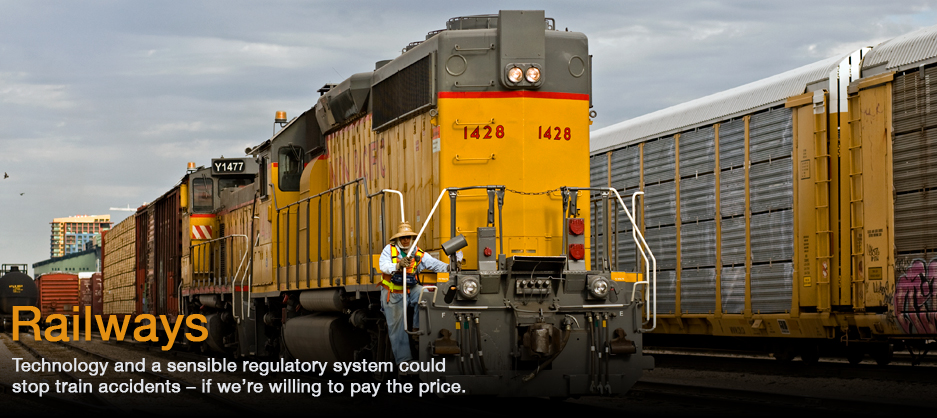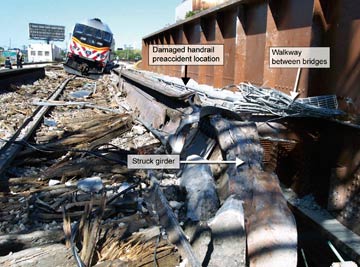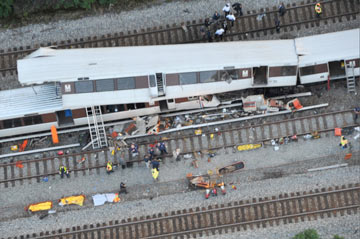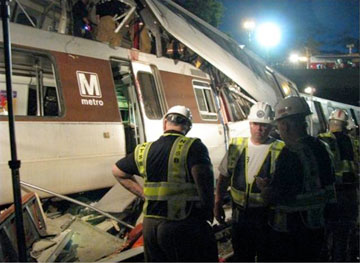“This was a complete maintenance failure,” said Bill Mooney, former administrator of rail units and vehicle inspection at CTA. “We had an inspection process that was allegedly being done. The management people who were responsible in making sure that it was being done and doing the audits failed.”
The NTSB issued 14 findings suggesting ways safety could be improved in Chicago. It told the FTA that it should bolster its safety oversight program and advised the Illinois governor that the Regional Transit Authority needed real regulatory power if accidents are to be prevented.
Ten of the recommendations have been implemented. The RTA, for example, now has two full-time employees working on safety issues when before there were none, said Grace Gallucci, the authority’s deputy director of research.
But four recommendations, including improved track inspections and better training and record-keeping, remain open.
Continuing problems
If proof was needed that problems remain on the “L,” it came in June, when sparks on the Red Line tracks ignited an underground fire.
Smoke wafted through a stopped train while passengers tried to figure out what to do, said Lindsey Ball, a passenger on the train.
“We got to a stop, but we couldn’t tell we were at a stop because it was solid black, filled with smoke,” Ball said.
As she struggled to make her way to the one set of stairs leading from the platform to the street above, Ball saw no CTA employees directing people to safety.
Meanwhile, CTA President Rich Rodriguez voiced his own complaint: The CTA didn’t have enough money to buy safer track grease, used to oil the tracks and make the ride smoother and quieter. It was the low-grade grease that ignited, according to the CTA’s investigation.
Money is a big problem for city and regional transit rail systems. The FTA reported this summer that it would take $50 billion to properly repair the largest systems, in New York, San Francisco, Chicago, Atlanta, Boston, Philadelphia and Washington, D.C. And it would take an additional $14.4 billion a year to keep all 48 of the nation’s systems in good repair.
Ian Savage, a transportation professor at Northwestern University, said it’s true that transit systems like the one in Chicago don’t have the money to fix tracks outright. But that’s not the biggest problem, he said. Chicago’s transit authorities, like those in Washington, D.C., showed an almost complete disregard for safety, he said.
“It’s a bit like those cheap romance novels,” Savage said. “In each city the characters are different, but it’s the exact same storyline.”
Federal Oversight
The NTSB made its first recommendation about oversight of the nation’s transit systems in 1981, when it said the FTA should be given regulatory power to make sure systems are safe.
Since then, the NTSB’s view has shifted back and forth. In 1991, the board issued recommendations encouraging the states to self-regulate. The reasoning was that individual rail systems are so unique they need their own oversight agencies, said Bill Grizard, director of safety at the American Public Transportation Association, an advocacy group for public transit agencies.
“Even though they’re similar in the way they provide service, they’re much farther apart in the way they operate,” he said.
But in the wake of the Metro crash in Washington, D.C., Congress may revisit the idea of federal oversight. Legislation that would make the FTA responsible for all transit rail safety was proposed last November but has stalled in the Senate.
The Metro crash “really was the catalyst that brought everything together and made them see that they really did need to have a broader jurisdictional base like the other DOT agencies,” Kenneth Mead, former DOT inspector general, said in an interview.
Under the bill, states would be able to continue providing their own oversight if they prove they can meet new, stringent safety standards to be developed by the FTA. States with large oversight agencies for multiple systems – as is the case with the California Public Utilities Commission, which oversees 12 rail systems – would likely opt to continue operating their own systems.
Smaller agencies that oversee a single transit system, such as those in Chicago and Washington, might leave oversight to the FTA because it would be cheaper than hiring their own full-time safety staff, said Mooney, the former Chicago Transit Authority administrator.
The NTSB supports the legislation, as does the American Public Transportation Association, said Martin Schroeder, chief engineer for the association, which develops voluntary safety standards for transit rail.
“If our industry is not following our standards because we don’t have a club big enough, then get somebody who does,” he said.
Sept. 26, 2010


 An Uncertain Future
An Uncertain Future

